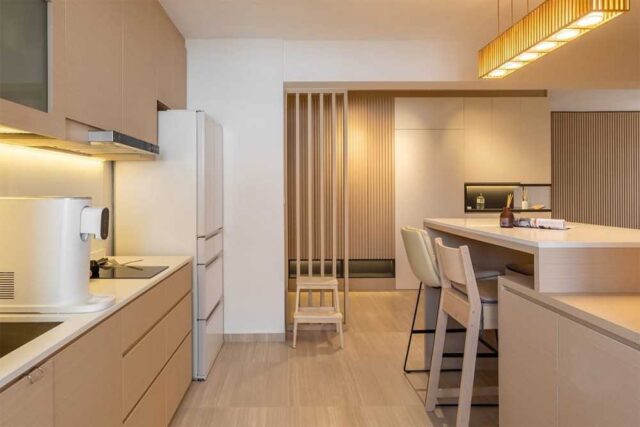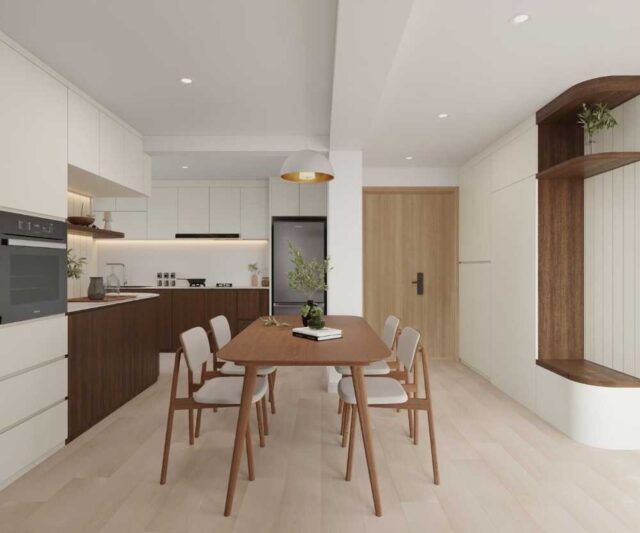When it comes to your kitchen, the backsplash might seem like a small detail, but it packs a punch in both style and functionality. Really, it’s there to catch splatters and spills and more.
Here are tips for installing the right one for your needs.
Personal Style and Kitchen Aesthetics
When it comes to your kitchen backsplash, you want to make sure it aligns with your personal style and enhances the overall aesthetic of your space. This means considering factors like cabinet color, countertop material, and the overall vibe of your kitchen.
- Assess your kitchen style: Take a good look around your kitchen and see what style elements are already in place. Think about whether your kitchen leans more modern, traditional, or maybe somewhere in between
- Find some inspiration: Get into design magazines or browse online for kitchen backsplash design inspiration. Look for kitchens that have a similar vibe to yours and see what kind of backsplashes they’ve used
- Pay attention to color and texture: You want something that complements your existing color scheme and adds a little texture to the mix
- Assess your kitchen’s needs: Before diving into colors and materials, consider the primary function of your kitchen. Is it a high-traffic area prone to splashes and stains? Or is it more of a show kitchen used occasionally? These factors influence the type of material you should consider. For example, porcelain tiles resist stains and are easy to clean, making them ideal for busy kitchens, whereas glass tiles might be better suited for less frequented areas due to their aesthetic appeal and lighter maintenance needs.
Practical Considerations

Sure, a cool looking backsplash is important, but you also want to make sure it can stand up to the rigors of daily life in the kitchen. That means thinking about things like maintenance, durability, and how well it’ll hold up to your cooking adventures.
- Assess maintenance needs: Take a moment to think about your cooking habits and how much time you want to spend cleaning up.
- Pick tough materials: Porcelain, ceramic, and glass tiles are all great options because they’re generally tough, stain-resistant, and easy to clean
- Consider function over form: Remember to prioritize functionality, especially in areas like behind the sink and stove
Think About Maintenance
Some materials require more maintenance than others. If you’re not interested in high-maintenance surfaces, consider quartz or ceramic tiles, which are easy to clean and do not need sealing. Materials like natural stone, while beautiful, will require regular sealing to prevent stains. Moreover, consider the impact of your cooking habits on the backsplash; frequent frying can leave grease stains that are harder to clean from porous surfaces.
Additionally, if you opt for materials like wood or metal, you will need to polish and treat them regularly to maintain their luster and prevent damage. It’s also worth checking if your chosen material is resistant to common kitchen acids like lemon juice and vinegar, which can etch or discolor sensitive surfaces.
Size and Scale Matter

The size of the tiles can drastically affect the appearance of your kitchen. Larger tiles can make a small kitchen appear bigger, whereas smaller tiles, like mosaics, can add texture and depth but might make the space feel busier. Consider the scale of your kitchen when selecting the size of your backsplash tiles.
Additionally, the size of the grout line can also influence the kitchen’s look; thinner grout lines often provide a more seamless appearance, while thicker ones can be a design feature. It’s important to balance the proportion of tiles with the overall size of the kitchen to maintain a harmonious look. Also, think about the installation process; larger tiles are typically easier and faster to install than smaller, more intricate designs.
Budget Accordingly
Your budget will significantly influence your choice of backsplash material and design. While it’s tempting to opt for cheaper materials, consider the longevity and durability of your investment. Sometimes, spending a bit more on a quality product can save you money in the long run with lower maintenance costs and fewer replacements.
Be sure to also factor in the cost of installation materials like grout and adhesive, which can vary depending on the type of tile you choose. Additionally, some luxury materials like hand-painted tiles or custom glass can come with significant upcharges but offer a unique aesthetic not achievable with standard options. Research potential future trends as well; investing in a current trend might require updates sooner than timeless choices.
Installation Considerations

Decide whether you will DIY the backsplash installation or hire a professional. While DIY can save money, improper installation can lead to problems down the line, especially with more complex materials like natural stone or glass. Professional installation might be more costly but can ensure that your backsplash is installed correctly and remains durable.
If choosing to DIY, thorough preparation and research into the proper methods for your specific material are crucial. Consider attending a workshop or watching detailed tutorial videos before starting. Also, keep in mind that professional installers usually offer warranties on their work, providing added security that DIY efforts do not.
Measure Twice, Buy Once
Nobody wants to deal with the headache of buying too much or too little backsplash material. That’s why it’s so important to get your measurements right the first time around. Really, it’ll save you a lot of hassle in the long run.
- Gather your tools: Grab a measuring tape, pencil, and some paper – you’re going to need them. Or, there’s nothing wrong with bringing in a professional for this part
- Measure everything: Take accurate measurements of the area you want to cover with your backsplash. Don’t forget to account for any obstacles like outlets or cabinets
- Add a little extra: To be on the safe side, add about 10% to 15% extra to your total square footage. This gives you a little wiggle room for mistakes or unexpected mishaps
- Double-check everything: Before you hit that buy button, or head to the checkout line take a second to double-check your measurements. You’ll thank yourself later
Kitchen backsplashes are important parts of any clean kitchen. Try out these tips and get the right one for you needs.




